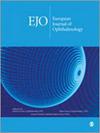求助PDF
{"title":"Anatomical and functional outcome after vitrectomy for macular hole detachment in high myopia.","authors":"Na Yang, Xiaoying Wen, Yueling Zhang","doi":"10.1177/11206721251372399","DOIUrl":null,"url":null,"abstract":"<p><p>PurposeTo assess structural and functional retinal recovery after vitrectomy for macular hole retinal detachment (MHRD) in high myopia using optical coherence tomography (OCT), OCT angiography (OCTA), and multifocal electroretinography (mfERG), focusing on reattachment rates, macular hole closure patterns, visual outcomes, and correlations between imaging and functional metrics.MethodsA retrospective study of 45 eyes with high myopia (axial length ≥26.0 mm) undergoing vitrectomy with internal limiting membrane peeling and silicone oil tamponade. Preoperative and postoperative evaluations at 1 week, 1, 3, 6, and 12 months included best-corrected visual acuity (BCVA, logMAR), OCT, OCTA (superficial capillary plexus vessel density, SCPVD), and mfERG (central retinal N1/P1 amplitudes). Statistical analyses compared longitudinal outcomes.ResultsRetinal reattachment achieved 95.56% (43/45 eyes). Macular closure rates: U-type (normal foveal contour, 71.74%), V-type (steep foveal contour, 4.35%), W-type (flattened hole margins without neurosensory retina restoration, 23.91%). BCVA improved significantly from 1.33 ± 0.36 (baseline) to 0.88 ± 0.08 logMAR (<i>P</i> < 0.01). OCTA showed increased SCPVD in parafoveal regions (rings 2-3, <i>P</i> < 0.05). mfERG revealed progressive N1/P1 amplitude recovery (<i>P</i> < 0.01), with stable latencies.ConclusionVitrectomy achieved high anatomical success and functional recovery in MHRD, with structural improvements preceding functional gains. OCTA and mfERG provided complementary insights into vascular and electrophysiological restoration. Persistent W-type closures highlight challenges in complex cases, underscoring the need for refined surgical strategies. Multimodal assessments are critical for monitoring postoperative recovery.</p>","PeriodicalId":12000,"journal":{"name":"European Journal of Ophthalmology","volume":" ","pages":"11206721251372399"},"PeriodicalIF":1.4000,"publicationDate":"2025-09-15","publicationTypes":"Journal Article","fieldsOfStudy":null,"isOpenAccess":false,"openAccessPdf":"","citationCount":"0","resultStr":null,"platform":"Semanticscholar","paperid":null,"PeriodicalName":"European Journal of Ophthalmology","FirstCategoryId":"3","ListUrlMain":"https://doi.org/10.1177/11206721251372399","RegionNum":4,"RegionCategory":"医学","ArticlePicture":[],"TitleCN":null,"AbstractTextCN":null,"PMCID":null,"EPubDate":"","PubModel":"","JCR":"Q3","JCRName":"OPHTHALMOLOGY","Score":null,"Total":0}
引用次数: 0
引用
批量引用
Abstract
PurposeTo assess structural and functional retinal recovery after vitrectomy for macular hole retinal detachment (MHRD) in high myopia using optical coherence tomography (OCT), OCT angiography (OCTA), and multifocal electroretinography (mfERG), focusing on reattachment rates, macular hole closure patterns, visual outcomes, and correlations between imaging and functional metrics.MethodsA retrospective study of 45 eyes with high myopia (axial length ≥26.0 mm) undergoing vitrectomy with internal limiting membrane peeling and silicone oil tamponade. Preoperative and postoperative evaluations at 1 week, 1, 3, 6, and 12 months included best-corrected visual acuity (BCVA, logMAR), OCT, OCTA (superficial capillary plexus vessel density, SCPVD), and mfERG (central retinal N1/P1 amplitudes). Statistical analyses compared longitudinal outcomes.ResultsRetinal reattachment achieved 95.56% (43/45 eyes). Macular closure rates: U-type (normal foveal contour, 71.74%), V-type (steep foveal contour, 4.35%), W-type (flattened hole margins without neurosensory retina restoration, 23.91%). BCVA improved significantly from 1.33 ± 0.36 (baseline) to 0.88 ± 0.08 logMAR (P < 0.01). OCTA showed increased SCPVD in parafoveal regions (rings 2-3, P < 0.05). mfERG revealed progressive N1/P1 amplitude recovery (P < 0.01), with stable latencies.ConclusionVitrectomy achieved high anatomical success and functional recovery in MHRD, with structural improvements preceding functional gains. OCTA and mfERG provided complementary insights into vascular and electrophysiological restoration. Persistent W-type closures highlight challenges in complex cases, underscoring the need for refined surgical strategies. Multimodal assessments are critical for monitoring postoperative recovery.
高度近视黄斑孔脱离玻璃体切除术后的解剖和功能结果。
目的利用光学相干断层扫描(OCT)、OCT血管造影(OCTA)和多焦视网膜电图(mfERG)评估高度近视患者黄斑孔视网膜脱离(MHRD)玻璃体切除术后视网膜结构和功能恢复情况,重点关注再附着率、黄斑孔闭合模式、视力结果以及成像和功能指标之间的相关性。方法对45例高度近视(眼轴长≥26.0 mm)行玻璃体切除术并内限制膜剥离和硅油填塞的回顾性研究。术前和术后1周、1、3、6和12个月的评估包括最佳矫正视力(BCVA, logMAR)、OCT、OCTA(浅毛细血管丛血管密度,SCPVD)和mfERG(中央视网膜N1/P1振幅)。统计分析比较了纵向结果。结果视网膜再植率95.56%(43/45眼)。黄斑闭合率:u型(正常中央凹轮廓,71.74%),v型(陡峭中央凹轮廓,4.35%),w型(平坦孔缘,无神经感觉视网膜修复,23.91%)。BCVA从1.33±0.36(基线)显著改善至0.88±0.08 logMAR (P P P)
本文章由计算机程序翻译,如有差异,请以英文原文为准。

 求助内容:
求助内容: 应助结果提醒方式:
应助结果提醒方式:


